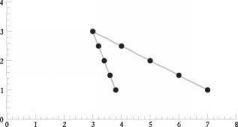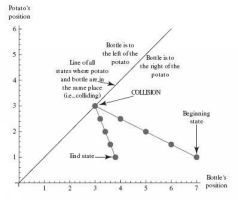“When you say ‘trajectory’ I think of something flying through the air,” Barb said, “but I don’t follow what you mean when you use that word in this twelve-dimensional space that isn’t like a space at all.”
“Well, let’s make it ultrasimple and restrict the bottle and the potato to the x-axis,” I said, “and ignore their rotations.” I moved them around thus:

“Can you use your slate to record their x positions?” I asked.
“Sure,” he said, and after a few moments, showed me this:
“I’m going to smash them into each other,” I said, “in slow motion, of course. Try to make a record of their positions, if you would.” And, much as before, I began to move the potato and the bottle in small increments, calling out “Mark” when I wanted him to add a new line to his chart.

“The bottle’s moving faster,” he observed, as we worked.
“Yeah. Twice as fast.” I ended up holding the potato on top of the bottle at 3.

“They just hit each other,” I said, “and so now they are going to bounce apart. But they are going to move slower, because the potato got mashed in the collision and some energy was lost.” With a little over-the-shoulder coaching from me, Barb added several postsmashup points to the table:

“There,” I said, letting go of the projectiles, and clambering back up to my feet. “Now, all of this action happened along a straight line. So, this is a one-dimensional situation, if you keep thinking in Saunt Lesper’s coordinates. Saunt Hemn, though, would do something here that might strike you as strange. Hemn would think of each row of the table as specifying a point in a two-dimensional configuration space.”
“Treat each pair as a point,” Barb translated, “so, the beginning point is (7, 1) and so on.”
“That’s right. Can you make a plot of that for me?”
“Sure. It’s trivial.”

“That’s weird!” Barb exclaimed. “It’s like Saunt Hemn has turned the whole situation inside out.”
“Well, give me the chalk for a minute and I’ll annotate it in ways that will help you make sense of it,” I said. A few minutes later, we had something that looked like this:

“The collision line,” I said, “is nothing other than the set of all points where the bottle and the potato happen to be at the same place—where their coordinates are equal to each other. And any theor, looking at this plot, even without knowledge of the physical situation—the bottle, the potato, the floor—can see right away that there is something special about that line. The state of the system progresses in an orderly and predictable fashion until it touches that line. Then something exceptional happens. The trajectory makes a hairpin turn. The points become more closely spaced—this means that the objects are moving more slowly, which means that the system has lost energy somehow. I don’t expect you to be bowled over by this, but maybe this can give you an inkling of why theors like to use configuration space as a way to think about physical systems.”
“There’s got to be more to it than that,” Barb said. “We could have just plotted this in a simpler way.”
“This is simpler,” I insisted. “It is closer to the truth.”
“Are you talking about the Hylaean Theoric World now?” Barb asked, half whispering and half gloating, as if this were just about the naughtiest thing that a fraa could do.
“I’m an Edharian,” I answered. “No matter what some people around here might think…that’s what I am. And naturally we seek to express what we are thinking in the simplest, most elegant way possible. In many—no, most—cases that are interesting to theors, Saunt Hemn’s configuration space does that better than Saunt Lesper’s space of x, y, and z coordinates, which you’ve been forced to work in until now.”
Something occurred to Barb: “The bottle and the potato each had six numbers—six coordinates in Hemn space.”
“Yes, in general it takes six numbers to represent the position of something.”
“A satellite in orbit needs six numbers too!”
“Yes—the orbital elements. A satellite in orbit always needs a six-dimensional Hemn space, no matter which coordinate system you use. If you’re using Saunt Lesper’s Coordinates, it leads to the problem you were complaining of earlier—”
“The xs and ys and zs don’t really tell you anything!”
“Yes. But if you transform it into a different six-dimensional space, using six different numbers, it becomes very clear, the same way that the bottle-potato scenario became clear when we chose an appropriate space in which to plot it. For a satellite, those six numbers are the eccentricity, the inclination, the argument of perihelion, and three others with complicated names that I’m not going to rattle off now. But just to name a couple of them: the eccentricity tells you, at a glance, whether or not the orbit is stable. The inclination tells you whether it’s polar or equatorial. And so on.”
CALCA 3: Complex Versus Simple Protism
A supplement to Anathem by Neal Stephenson
“HERE’S THAT TWO-BOX DIAGRAM we’ve all seen,” Criscan began, and drew something like this in the dust:
“The arrow says that entities in the Hylaean Theoric World are capable of causing effects within the Arbran Causal Domain but not vice versa. And if you take the trouble to unpack what it is that people are asserting when they chalk one of these up on a slate, it boils down to a small set of premises that define what we call Protism. And I know that you two are well aware of these, but with your indulgence I’m going to run through them briefly just so that we can be sure we are starting from the same place.”
“Please do,” I said.
“Be my guest,” Lio said.
“All right. The first assertion is: entities that are the subject matter of theorics exist independently of human perceptions, definitions, and constructions. Theors don’t create them; theors merely discover them. And the second premise is that the human mind is capable of perceiving such entities; which is exactly what theors are doing, when they discover them.”
“We’re with you so far,” I said.
“Very well,” Criscan said, “now, if you want to proceed beyond merely rattling off those two premises, you need to supply an account of how it is that the human mind is capable of obtaining knowledge about theorical entities, which, according to the first premise, are non-spatiotemporal and do not stand in a normal causal relationship to the entities that make up the cosmos as we know it. And various arguments have been put forward over the millennia as metatheoricians have tried to supply that account. For example, Halikaarn took a lot of heat from the Procians because he thought that our brains contained an organ that was responsible for this.”
“An organ? Like a gland, or something?” Lio asked.
“Some interpreted it that way, which helps explain why he took so much heat for it. But this was probably a translation error. Halikaarn was pre-Reconstitution, of course, so he was not writing in Orth but in one of the minor languages of his day. The person who translated his works into Fluccish did him a disservice by choosing the wrong word. Halikaarn wasn’t thinking of something like a gland. He was thinking of a faculty, an inherent ability of the brain, not localized in any one specific lump of tissue.”